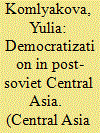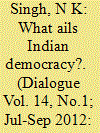| Srl | Item |
| 1 |
ID:
134123


|
|
|
|
|
| Publication |
2014.
|
| Summary/Abstract |
The author analyzes how the Central Asian countries (Kazakhstan, Uzbekistan, and Kyrgyzstan) are moving toward democracy, as well as the political and geopolitical reasons behind the United States' interest in the region triggered by the Soviet Union's disintegration and Washington's desire to consolidate its position in the post-Soviet space. It was determined to realize its interests by planting democratic values in the newly independent states and urging them to orientate themselves toward democratic principles when shaping their policies. In this way, the Central Asian countries could count on Washington's political support and economic aid.
In an effort to enter the world scene as democratic states, the Central Asian countries built state structures that relied on constitutions describing them as democratic states; they created a party and election system and passed laws on the freedom of speech, glasnost, etc. This, however, has not transformed the post-Soviet Central Asian republics into paragons of democracy: the clan system is very much alive in the corridors of power; Soviet mentality remains predominant among state officials (practically all the top figures preserved their posts in the newly independent states); and the influence of Russia and the authoritarian traditions inherited from the past is still very obvious.
|
|
|
|
|
|
|
|
|
|
|
|
|
|
|
|
| 2 |
ID:
127752


|
|
|
|
|
| Publication |
Frankfurt, Peace Research Institute frankfurt, 2013.
|
| Description |
37p.Pbk
|
| Series |
PRIF Report no.122
|
| Standard Number |
9783942532570
|
|
|
|
|
|
|
|
|
|
|
|
Copies: C:1/I:0,R:0,Q:0
Circulation
| Accession# | Call# | Current Location | Status | Policy | Location |
| 057578 | 324.609629/DRE 057578 | Main | On Shelf | General | |
|
|
|
|
| 3 |
ID:
196879


|
|
|
|
|
| Publication |
Switzerland, Palgrave Macmillan, 2023.
|
| Description |
xix, 310p.: figures, tableshbk
|
| Series |
Reform and Transition in the Mediterranean
|
| Standard Number |
9783031257988
|
|
|
|
|
|
|
|
|
|
|
|
Copies: C:1/I:1,R:0,Q:0
Circulation
| Accession# | Call# | Current Location | Status | Policy | Location | IssuedTo | DueOn |
| 060754 | 320.90561/ARI 060754 | Main | Issued | General | | RA70 | 09-Jul-2025 |
|
|
|
|
| 4 |
ID:
117122


|
|
|